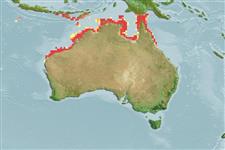>
Eupercaria/misc (Various families in series Eupercaria) >
Haemulidae (Grunts) > Plectorhinchinae
Etymology: Plectorhinchus: Greek, plektos = plaited + Greek, rhyngchos = snout (Ref. 45335); caeruleonothus: Name from the Latin words 'caeruleo' for blue and 'nothus' for bastard when combined as ‘Blue Bastard’ which has been commonly applied to this species by anglers for many years; referring to its blue sheen in life and difficulty to hook and land on artificial fly..
Environment: milieu / climate zone / depth range / distribution range
Ecologie
marien rifbewoner; diepte 6 - 30 m (Ref. 103290). Tropical; 9°S - 25°S, 101°E - 147°E (Ref. 103290)
Verspreiding
Landen | FAO regio's | Ecosystemen | Voorkomen | Point map | Introducties | Faunafri
Southwest Pacific: Australia (Western Australia toi Queensland).
Grootte / Gewicht / Leeftijd
Maturity: Lm ? range ? - ? cm
Max length : 100.0 cm TL mannelijk / geslacht onbekend; (Ref. 103290)
Korte beschrijving
Morfologie | Morfometrie
Dorsale stekels (totaal): 12; Dorsale zachte stralen (totaal): 18-20; Anale stekels 3; Anale zachte stralen: 6 - 7. This species is distinguished by the following features: D XII, 18-20 (rarely 20); A III, 6-7 (rarely III, 6); pectoral-fin rays 16-17 (usually 17); lateral-line scales 56-61 (modally 59); transverse scale rows above lateral line 15; gill rakers 7-9 + 18-20 = 25-29 (modally 26); in juveniles, pelvic fins reaching anus, slightly short of anus in adults; nostrils minute, 0.4-0.8 % SL, 2-3 times in distance from posterior nostril to eye; when fresh colouration in adults with body uniformly silver-grey, cheek and opercles blue-grey, rim of orbit and dorsal edge of maxilla dusky yellow, posterior margin of opercular membrane silver-grey, non-contrasting with remainder of opercle and adjacent body (Ref. 103290).
This species is found on sand, rubble and reef bottom but mostly in the intertidal zone, or shallow reef; one specimen trawled in a depth of 30 m. The most southerly record is a large individual estimated to be 100 cm in total length. Large individuals are most often solitary, foraging diurnally over relatively open expanses of soft substrate. Agonistic behavioural interactions have been recorded between individuals, individuals have often been observed to interact highly aggressively, engaging in one-on-one conflicts (Ref. 103290).
Levenscyclus en paargedrag
Maturiteit | Voortplanting | Paaien | Eieren | Fecunditeit | Larven
Johnson, J.W. and J.W. Wilmer, 2015. Plectorhinchus caeruleonothus, a new species of sweetlips (Perciformes: Haemulidae) from northern Australia and the resurrection of P. unicolor (Macleay, 1883), a species previously confused with P. schotaf (Forsskål, 1775). Zootaxa 3985(4):491-522. (Ref. 103290)
Status op de Rode Lijst van het IUCN (Ref. 130435)
Gevaar voor de mens
Harmless
Gebruik door de mens
Meer informatie
LandenFAO regio'sEcosystemenVoorkomenIntroductiesStocksEcologieDieetVoedselitemsVoedselconsumptieRantsoen
Lokale namenSynoniemenMetabolismePredatorenEcotoxicologieVoortplantingMaturiteitPaaienPaaiaggregatiesFecunditeitEierenOntwikkeling van de eieren
Leeftijd/GrootteGroeiLengte-gewichtLengte-lengteLengtefrequentiesMorfometrieMorfologieLarvenLarvale populatiedynamiekRekruteringAbundantieBRUVS
ReferentiesAquacultuurAquacultuurprofielKweeklijnenGeneticaElectrophoresesErfelijkheidZiektesVerwerkingNutrientsMassaconversie
Tools
Speciale rapporten
Download XML
Internetbronnen
Estimates based on models
Fylogenetische diversiteitsindex (Ref.
82804): PD
50 = 0.5000 [Uniqueness, from 0.5 = low to 2.0 = high].
Bayesian length-weight: a=0.01380 (0.00670 - 0.02842), b=3.00 (2.83 - 3.17), in cm total length, based on LWR estimates for this Genus-body shape (Ref.
93245).
Trofisch niveau (Ref.
69278): 3.9 ±0.6 se; based on size and trophs of closest relatives
Weerstandsvermogen (Ref.
120179): Zeer laag, minimale populatieverdubbelingstijd meer dan 14 jaar (Preliminary K or Fecundity.).
Fishing Vulnerability (Ref.
59153): High vulnerability (60 of 100).
Nutrients (Ref.
124155): Calcium = 21.8 [8.7, 40.3] mg/100g; Iron = 0.445 [0.233, 0.856] mg/100g; Protein = 19.4 [17.5, 21.3] %; Omega3 = 0.106 [0.058, 0.178] g/100g; Selenium = 36.5 [20.4, 62.3] μg/100g; VitaminA = 57.3 [21.5, 147.8] μg/100g; Zinc = 0.964 [0.681, 1.396] mg/100g (wet weight);
